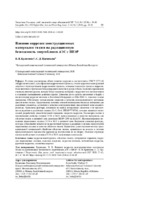| dc.contributor.author | Кравченко, В. В. | |
| dc.contributor.author | Цыганкова, С. Д. | |
| dc.coverage.spatial | Минск | ru |
| dc.date.accessioned | 2020-02-05T13:12:30Z | |
| dc.date.available | 2020-02-05T13:12:30Z | |
| dc.date.issued | 2020 | |
| dc.identifier.citation | Кравченко, В. В. Влияние коррозии конструкционных материалов твэлов на радиационную безопасность энергоблоков АЭС с ВВЭР = Effect of Corrosion of the Fuel Rod Construction Materials on the Radiation Safety of Nuclear Power Plants with PWR / В. В. Кравченко, С. Д. Цыганкова // Энергетика. Известия высших учебных заведений и энергетических объединений СНГ. – 2020. – № 1. – С. 89-98. | ru |
| dc.identifier.uri | https://rep.bntu.by/handle/data/63845 | |
| dc.description.abstract | В статье рассмотрены общее понятие коррозии в соответствии с ГОСТ 5272–68 «Коррозия металлов», классификация коррозионного процесса, стадии коррозии в виде функций энергии от пути протекания коррозионного процесса, основные показатели процесса коррозии. В соответствии c прогнозами Международного валютного фонда и Focus Economics произведена оценка количества средств, которые будут затрачены на борьбу с коррозией и ее последствиями в отдельных промышленно развитых странах. Динамика роста средств, вложенных в борьбу с последствиями коррозии металлов в Российской Федерации за 2016–2019 гг., показана в виде диаграммы. Обосновано использование циркония в качестве конструкционного материала для оболочки твэлов. Представлены значения сечений поглощения тепловых нейтронов для различных элементов, служащих в качестве конструкционных для активной зоны ядерного реактора. Приведены факторы, влияющие на выбор легирующих элементов и их процентное содержание в различных сплавах (Zr-2, Zr-4, ZIRLO™, M5®), которые являются специальной разработкой, способствующей снижению скорости коррозии. Рассмотрен состав и механические свойства сплавов Э110 и Э635, использованных в качестве материалов для оболочки твэлов в активной зоне реакторов ВВЭР-1200 на БелАЭС. Проанализировано поведение циркониевых сплавов Э110 и Э635 в активной зоне. Выделены основные факторы, которые существенно влияют на коррозионный процесс в реальных условиях эксплуатации циркониевых сплавов в качестве оболочек твэлов. Приведены существующие методы предварительной специальной обработки оболочек твэлов, хранящихся на воздухе в течение продолжительного промежутка времени до поступления их на сборку. Показана структура оксида на оболочках из сплавов Э110 и Э635, окисленных в автоклаве. | ru |
| dc.language.iso | ru | ru |
| dc.publisher | БНТУ | ru |
| dc.title | Влияние коррозии конструкционных материалов твэлов на радиационную безопасность энергоблоков АЭС с ВВЭР | ru |
| dc.title.alternative | Effect of Corrosion of the Fuel Rod Construction Materials on the Radiation Safety of Nuclear Power Plants with PWR | ru |
| dc.type | Article | ru |
| dc.identifier.doi | 10.21122/1029-7448-2020-63-1-89-98 | |
| local.description.annotation | The article considers the general concept of corrosion in accordance with GOST 5272–68 “Metal Corrosion”, the classification of the corrosion process, the stages of corrosion as energy function of the flow path of the corrosion process, the main indicators of the corrosion process. According to the forecasts of the International Monetary Fund and Focus Economics, the amount of funds that will be spent on counteracting corrosion and its consequences in selected industrialized countries has been estimated. The growth of funds invested in the counteracting the effects of metal corrosion in the Russian Federation for 2016–2019 is presented in the form of a diagram. The substantiation of the use of zirconium as a structural material for the shell of fuel rods has been fulfilled. The values of the thermal neutron absorption cross sections for various elements serving as structural elements for the core of a nuclear reactor are presented. Factors influencing the choice of alloying elements and their percentage in various alloys (Zr-2, Zr-4, ZIRLO™, M5®), which are the special development that reduce the corrosion rate, are also considered. The composition and mechanical properties of E110 and E635 alloys, which were used as materials for the fuel rods shell in the core of WWER-1200 reactors at the Belarusian NPP, are considered as well. The behavior of zirconium alloys E110 and E635 in the core is analyzed. The main factors that make a significant contribution to the corrosion process in actual operating conditions of zirconium alloys as fuel rods shell have been identified. The existing methods of preliminary special processing of fuel rods shells stored in the air for a long time before their receipt for assembly are presented. The structure of the oxide on the shells of alloys E110 and E635 oxidized in an autoclave is demonstrated. | ru |

